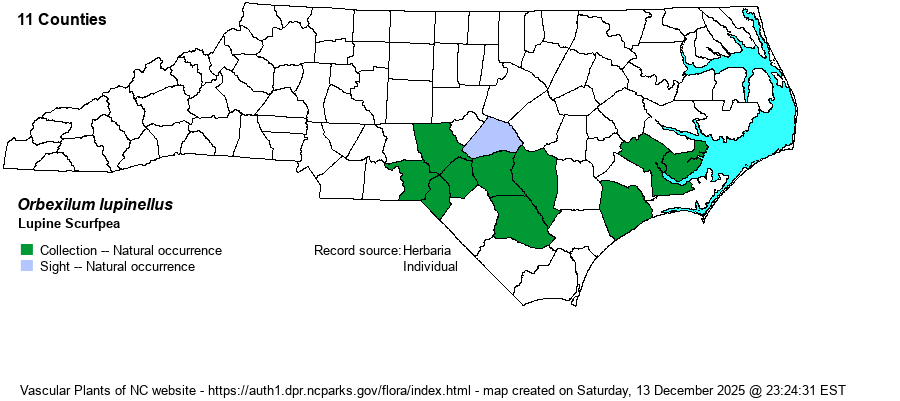| Author | (Michaux) Isely | |
| Distribution | Present over parts of the southern third of the Coastal Plain, but mainly found in the Sandhills region. Recorded north to Pamlico, Craven, Harnett, and Moore counties.
This is a Southern Coastal Plain species with a disjunct range. There is a cluster of records in southeastern NC, then it apparently skips over SC except in the far south, and then ranges from there to central FL and southern AL. | |
| Abundance | Uncommon in the Sandhills region in well-managed places such as Fort Bragg and Sandhills Game Land; very rare eastward. Not yet recorded from some counties where there seems to be suitable habitat, such as Pender, Jones, and Robeson counties. This species was formerly listed by the NC NHP as Significantly Rare but has been downgraded to the Watch List, thanks to the finding of many more sites in recent years. | |
| Habitat | This is a species found mainly in well-managed Longleaf Pine (Pinus palustris) sandhill communities, especially in loamy soils and thus more mesic and highly diverse sites. It is strongly favored by prescribed burning, as are most herbs in this ecosystem, and it can be very hard to find away from protected areas and/or frequently burned preserves. |
| Phenology | Blooms from May to July, and fruits from July to October. | |
| Identification | This is a most unusual plant owing to its "spidery" look. There are usually a few stems per plant, growing to about 10-12 inches tall, with many branches, giving a "wiry" yet bushy look. The leaves are divided into 5-7 palmately dissected leaflets, and these are extremely narrow and linear, about 2 inches long but barely 1/10-inch wide. Thus, an observer can literally walk right past this wispy-looking plant if not careful, especially if no flowers are visible. Thankfully, the several flowering stalks grow about 2-3 inches higher than the leaves and the handful of flowers in each cluster are violet to deep blue, despite being only about 1/4-inch long or less. Later in summer, you might catch the small single-segmented pods. Thankfully, where present, you can usually find a dozen or more plants, for if they grew only singly amid other vegetation the same height or taller, you might have extreme difficulty finding this most interesting species. | |
| Taxonomic Comments | Formerly named as Psoralea lupinellus. A few references may have the species spelled as Orbexilum lupinellum.
| |
| Other Common Name(s) | Sandhill Scurfpea, Piedmont Leather-root [yes, "Piedmont", where it is not even present!] | |
| State Rank | S3 | |
| Global Rank | G3G4 | |
| State Status | W1 | |
| US Status | | |
| USACE-agcp | | |
| USACE-emp | | |

